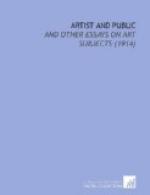If these gentlemen really believe that their capriciously chosen symbols are fit vehicles for communication with others, why do they fall back on that old, old symbol, the written word? Why do they introduce, in the very midst of a design in which everything else is dislocated, a name or a word in clear Roman letters? Or why do they give their pictures titles and, lest you should neglect to look in the catalogue, print the title quite carefully and legibly in the corner of the picture itself? They know that they must set you to hunting for their announced subject or you would not look twice at their puzzles.
Now, there is only one word for this denial of all law, this insurrection against all custom and tradition, this assertion of individual license without discipline and without restraint; and that word is “anarchy.” And, as we know, theoretic anarchy, though it may not always lead to actual violence, is a doctrine of destruction. It is so in art, and these artistic anarchists are found proclaiming that the public will never understand or accept their art while anything remains of the art of the past, and demanding that therefore the art of the past shall be destroyed. It is actual, physical destruction of pictures and statues that they call for, and in Italy, that great treasury of the world’s art, has been raised the sinister cry: “Burn the museums!” They have not yet taken to the torch, but if they were sincere they would do it; for their doctrine calls for nothing less than the reduction of mankind to a state of primitive savagery that it may begin again at the beginning.
Fortunately, they are not sincere. There may be among them those who honestly believe in that exaltation of the individual and that revolt against all law which is the danger of our age. But, for the most part, if they have broken from the fold and “like sheep have gone astray,” they have shown a very sheep-like disposition to follow the bell-wether. They are fond of quoting a saying of Gauguin’s that “one must be either a revolutionist or a plagiary”; but can any one tell these revolutionists apart? Can any one distinguish among them such definite and logically developed personalities as mark even schoolmen and “plagiarists” like Meissonier and Gerome? If any one of these men stood alone, one might believe his eccentricities to be the mark of an extreme individuality; one cannot believe it when one finds the same eccentricities in twenty of them.




